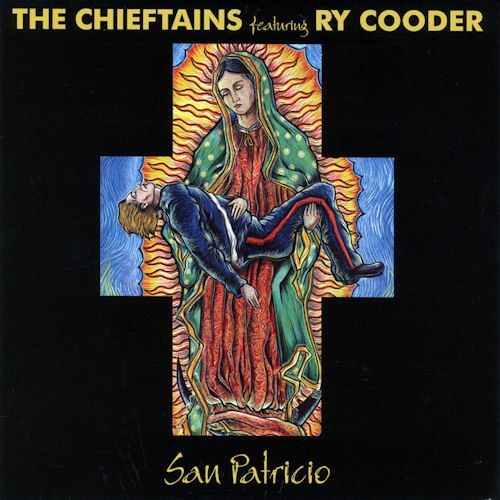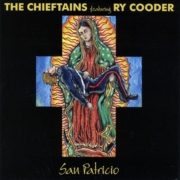THE CHIEFTAINS SAN PATRICIO
ARTIST: THE CHIEFTAINS
FEATURING RY COODER
TITLE: SAN PATRICIO
LABEL: Blackrock Records
RELEASE DATE: March 2010
 The package is so gorgeous it grabs you right away. Big bold southern colors and Latin looking iconography. gives you a warm feeling that this might be a special recording. First off the sparkling harp of Celso Duarte takes you right to Vera Cruz. But wait, there are the Chieftains – with Sonny's Mazurka. So Irish. Will this work? Then Lila Downs hypnotic vocals take command, and the whole thing gels in a most marvelous way, with the pipes, whistle, flute taking decidedly Latin lines, and seemingly having a ball. Then back to the Mazurka in the end, and you realize, this is going to be gooood.
The package is so gorgeous it grabs you right away. Big bold southern colors and Latin looking iconography. gives you a warm feeling that this might be a special recording. First off the sparkling harp of Celso Duarte takes you right to Vera Cruz. But wait, there are the Chieftains – with Sonny's Mazurka. So Irish. Will this work? Then Lila Downs hypnotic vocals take command, and the whole thing gels in a most marvelous way, with the pipes, whistle, flute taking decidedly Latin lines, and seemingly having a ball. Then back to the Mazurka in the end, and you realize, this is going to be gooood.
This is another in the Chieftains tradition of collaboration albums, and as they say, the ingredients make the stew. The ingredients here are rich, varied, and first rate. Los Folkloristas, one of the most accomplished Mexican folk ensembles going, appear with the irresistible Golondrina, a whistle/flute led dance tune that works really well paired with another Mexican tune, El Zacate. The intensity builds with flute and fiddle in the background, then the pipe drones swell, and you can almost feel the Irishmen carried away and inspired to launch into a Kerry Polka, with lilting by Kevin Conneff. Then back into El Zacate. Though this is meticulously arranged stuff, there is a sense of fun and spontaneity which is infectious.
A La Orilla de Un Palmar is slow, sweet and spare, with Linda Ronstadt's lovely voice paired with beautiful harmonies by Ersi Arvizu and Ry Cooder's perfect guitar. Cooder's contribution to this recording, though spare; he only appears on three cuts, nevertheless always hits the right note. The very right note. His duet with Van Dyke Parks on Cancion Mixteca (Intro) is poetic and pure. And his own song and singing on The Sands of Mexico carry the story the San Patricios in a charming, innocent and ironically heartbreaking way. The San Patricios, for those not familiar with their story, were an Irish brigade in the Mexican-American war, who found they had much more in common with those they were sent to fight, and changed sides, with disastrous consequences for themselves. So this album is a tribute to the connections between the Irish and Mexican cultures, music, and soul.
Los Cenzontles, a Nahuatl word that means Mockingbird, rock in a most traditional and riveting manner on El Chivo. Their vocals are given a spotlight on Ojitos Negros that is well deserved. Their voices are strong, the blend perfect, and their sound warm and 'muy hermoso'. This group is associated with a cultural organization teaching traditional Mexican musical arts in San Pablo, California, and from what they demonstrate on this recording, they are doing the work of the muses.
Luz de Luna is sung by Chavela Vargas, an icon of Mexican music, particularly the ranchera genre. But her influence is wide in other genres, and in America and Europe. Pedro Almodovar, famed Spanish film director, has called hers, the "rough voice of tenderness." Her performance here is a real treat. She draws you in like an aged yet ageless angel of emotion, and you want to listen to this song over and over.
Los Tigres del Norte, popular Norteño band from Sinaloa, Mexico, do Cancion Mixteca in corrido style. The accordion playing is wonderful, inventive and playful, and gives a great taste of the style. The Chieftains remain very low in the mix, which is a good thing here. Really, throughout this recording they choose to lay back, or stand out in a way that serves the music well, and the whole gains wonderfully from this tasteful mixing.
La Negra Graciana was a street performer for most of her life, performing the Son Jarocho of Vera Cruz, singing and accompanying herself on the Vera Cruz Harp, in the "old style." She was discovered and recorded in her sixties, and has achieved recognition for her charming fresh vocals and harp accompaniment. Here she is accompanied by the Cheiftains very tastefully and the result is a delight.
I have a weakness for Son Huasteco, with its call and response form, its falsetto vocal breaks and fantastic fiddle virtuosity. Here Los Camperos de Valles present this music powerfully and so, so well. Moloney adds a bit of pipe drone, Sean Keane doubles the fiddle for a respectful, non intrusive, yet mightily enjoyable piece of music.
Actor Liam Neeson recites a poem on the San Patricios, with accompaniment by the Chieftains and the Banda de Gaita de Batallon, an accomplished Mexican Highland Pipe band. I was surprised at how well this worked. Much more formal and cinematic, yet it didn't get too schmaltzy for me.
Moya Brennan, of Clannad fame, sings and plays her harp on a beautifully sad Lullaby for the Dead, which features Moloney's always evocative and well played pipes. This completely Irish piece fits with the rest of the album, providing a link to the lyricism which links the slower Latin pieces with the Irish.
The only other well known guest artist on the album was Galician virtuoso piper Carlos Nunez. I was a little disappointed that he was so far back in the mix it was difficult to really hear him. Of course I am a Gaita (Galician Bagpipe) fanatic. And I have to admit the pieces he played on were lovely.
So, here we have a southern sky full of musical stars, all used very well and presented in a lovely mix that is diverse, exciting, respectful, and mixed very tastefully with the Chieftains own deep musical roots and shining skills. And the Chieftains San Patricio is above a beautiful, most rewarding listen for anyone, but most especially for those unfamiliar with Latin music.
Kevin Carr has a touch of musical attention deficit disorder; he plays with Wake the Dead (Celtic/Grateful Dead folk orchestra), Hillbillies from Mars (folk fusion dance band with roots that show), Les Tetes de Violon (Quebecois fiddle band), Charanga (Galician style big band) and Confluence (Irish and Original, with a full complement of family members). He also maintains and plays a large stable of bagpipes.













